





Typhoid
The infectious disease proceeding with damage of lymphatic system of intestines, severe intoxication and bacteremia, rozeolezny rash, increase in a liver, spleen and, in certain cases, with enteritis is called a typhoid.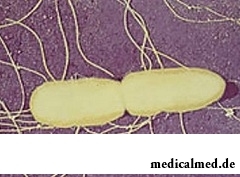
Reason and mechanism of development of a disease
The causative agent of a typhoid is the typroid stick. She breeds in an intestines gleam, and then through his mucous membrane begins to get into the lymphatic device (Peyerova of a plaque, solitary follicles, regional lymph nodes). Further microbes from lymph nodes get to circulatory system, leading to development of bacteremia. At death of the causative agent of a typhoid the toxin causing development of the expressed intoxication of an organism of the patient is emitted.
Typhoid epidemiology
Source of an infection are patients and bacilli carriers which allocate the causative agent of a typhoid with urine and fecal masses. Special danger is constituted by the carriers of a typroid stick working in child care facilities and at the enterprises of food.
The microbe gets into a human body through a mouth. There are next ways of infection with a typhoid:
- Contact and household;
- Food;
- Water.
An important role in transmission of infection is played by flies.
People of any age are susceptible to a typhoid, but most often it strikes children of school age. After it specific and rather durable immunity therefore repeated cases of a typhoid are practically not observed forms.
Typhoid: symptoms
The incubation interval, i.e. the period from the infection moment before emergence of the first symptoms of a disease at a typhoid averages two weeks.
The disease begins to develop gradually from fervescence. Temperature rises in steps and reaches 40 degrees of S. U of the patient the febricula accrues, appetite disappears, there are locks, the sleep is interrupted.
At a palpation of a stomach reveal increase in a liver and spleen, rumbling in the right ileal part of a stomach. Language is laid over by a thick layer of a plaque, is edematous. On its edges prints from teeth are quite often visible.
In a week from the beginning of emergence of the first symptoms of a typhoid in the patient the oglushennost, drowsiness, nonsense begin to appear.
At a typhoid relative bradycardia - discrepancy of pulse rate to temperature which is available for the patient is observed. This symptom of a typhoid arises owing to severe intoxication and defeat of cardiovascular system.
For 9 - 10 days from the beginning of a disease on skin of a back, a breast and a stomach rozeolezny rash develops small, gentle-pink color. Elements of rash are slightly raised over skin and disappear when pressing on them.
In 10 – 15 days from the beginning of fervescence symptoms of a typhoid begin to disappear gradually. Body temperature decreases lytically (smoothly) and there comes the reconvalescence period (recovery and recovery of an organism).
Typhoid complications
Complications at a typhoid usually meet seldom and are most often observed at children of younger age and elderly people. They are connected with ulcer process in intestines: perforation of ulcers and/or bleeding from them.
Analyses on a typhoid
Diagnosis of a typhoid, especially at early stages of a disease, presents certain difficulties. For confirmation of the diagnosis laboratory diagnostic methods are used. In the onset of the illness carry out crops of blood (hemoculture). For this analysis on a typhoid from a vein of the patient take 10,0 ml of blood and with observance of measures of an asepsis transfer it to the glass sterile bottle containing bilious broth.
Since the beginning of the second week of a disease, make statement of reaction of Vidal. This analysis on a typhoid is more valuable at its repeated carrying out when it is possible to reveal increase of an antiserum capacity.
From 15 in the afternoon from the beginning of a disease carry out bacteriological crops a calla and urine.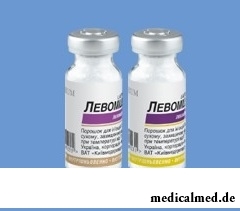
In the very first days of a disease in the general blood test reveal a moderate leukocytosis (increase in quantity of leukocytes) which is replaced further by a leukopenia (decrease in quantity of leukocytes).
Thus, analyses on a typhoid, allow doctors timely and to precisely make the correct diagnosis and to appoint to the patient the correct treatment.
Typhoid: treatment
At a typhoid observance by patients of a high bed rest which has to begin from the first days of a disease is very important and proceed not less than two more weeks after normalization of body temperature.
Drug treatment of a typhoid is carried out with use of antibiotics. Most often use levomycetinum or ampicillin. Antibacterial therapy is continued and after temperature declines.
At the expressed intoxication carry out disintoxication therapy (intravenous administration of saline solutions, glucose, vitamins).
An important role in the correct treatment of a typhoid is played by a dietotherapy. The wiped soups, fermented milk products, kissels, vegetable purees, soft-boiled eggs, steam cutlets, croutons from white loaf are allowed the patient. Drink has to be plentiful that helps to reduce expressiveness of symptoms of intoxication.
Typhoid: prevention
In fight against spread of this disease the large role is played by well organized work of the public health service exercising supervision of food stuffs and water. Carrying out regular inspections on a carriage of a typroid stick of staff of child care facilities, a water intake, the enterprises of food, etc. is necessary that is an important measure of prevention of a typhoid.
All patients have to be isolated to an absolute recovery. Their extract from a hospital can be made only after negative takes of triple bacteriological researches a calla and urine.
In the center of a disease final disinfection shall be carried out current, and after hospitalization of the patient or his recovery.
Personal prevention of a typhoid consists in the most strict observance of usual sanitary and hygienic measures – washing of hands after visit of a toilet and before food, washing of vegetables and fruit before consumption. It is impossible to drink unboiled water from unchecked sources.
There are very curious medical syndromes, for example, persuasive swallowing objects. In a stomach of one patient suffering from this mania 2500 foreign objects were revealed.
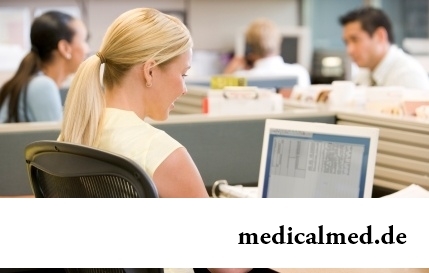
About 10-15 years ago existence of the computer in the apartment of the Russian was considered as a rarity and office rooms were only on перв...
Section: Articles about health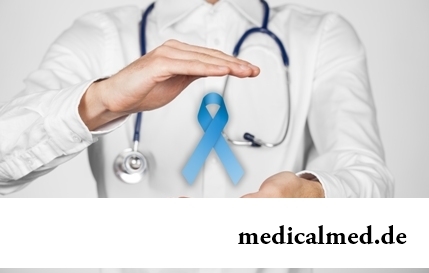
Aspirin (acetylsalicylic acid) – one of those drugs which are known literally to all. It is available in each home first-aid kit, and many accept it at the first signs of an indisposition, often without having a fair idea of properties and a therapeutic eff...
Section: Articles about health
Dietary supplements (dietary supplements) for the last decades were so thoroughly included into our life that, apparently, it is already impossible to find the person who at least once did not try them. At the same time, most of our compatriots have a vague idea of what dietary supplements as they affect a human body consist of and what differ from the real medicines in. Let's try to understand these questions, and at the same time and to understand, such additives are how necessary for us....
Section: Articles about health
It is difficult to revaluate importance of kidneys for an organism. These bodies not only perform work on purification of blood of decomposition products and выв...
Section: Articles about health
Cold, puffiness of a nose, itch, the watering eyes - characteristic symptoms of the allergic rhinitis resulting from hit of allergens (pollen, house dust, hair of animals, etc.) on a mucous membrane of a nose. Unpleasant feelings often deliver беспоко...
Section: Articles about health
The depression not without reason is considered one their main troubles of our century: for scientific and technical progress, acceleration of rate of life and a surplus of information of people it is forced to pay with stresses, negative emotions and weakening of protective forces of an organism. As a result widely the states which are characterized by the increased uneasiness, falling of interest in life, spiritual and physical discomfort extend....
Section: Articles about health
The words "disease" and "patient" not without reason come from one root – "pain". As a rule, symptoms of illnesses thoroughly spoil the patient...
Section: Articles about health
The state of health of the person depends on many factors. One of the most important is the constant, but not exhausting a physical activity. In the presence of various illnesses specialists often advise patients to do swimming which by right borrows ведущ...
Section: Articles about health
Heart disease and blood vessels lead to disturbance of blood supply of bodies and fabrics that involves failures in their work, deterioration in health of the person, decrease in its working capacity and standard of living. Annually more than 17 million inhabitants of our planet perish from pathologies such....
Section: Articles about health
All of us, unfortunately, should face flu nearly an every year. It would seem, so frequent disease has to be study...
Section: Articles about health
Diapers for adults – individual one-time means of hygiene which in some situations is irreplaceable and from such situations any person is not insured. Though nobody perceives need of their use with enthusiasm, however without it to a sra...
Section: Articles about health
Ability of an organism to resist to adverse environmental factors (to impact of temperature drops, humidity and pressure, to the attacks of causative organisms, etc.) directly depends on what the person eats. Business here not only in that cells of a body received a necessary set of nutrients, vitamins and microelements. Scientists established that such components which are capable to influence negatively immune system, in connection with also are a part of foodstuff...
Section: Articles about health
Dark circles (bruises) under eyes – a shortcoming with most of which often fight against the help of cosmetics (proofreaders, salons...
Section: Articles about health
The number of long-livers is very small. One person from 5 thousand lives up to age of 90 years, and the centenary boundary steps over only one of 20 thousand. However, doctors claim that each of us is quite able to affect own destiny. At the same time speech to Ida...
Section: Articles about health
Practice of use of table salt in the therapeutic purposes contains not one century. Applications which do by means of the fabric impregnated with saline solution are considered especially effective. They have antibacterial and antiinflammatory effect, help to heal wounds, exempt fabrics from excess liquid. Hypertonic salt solution of potassium chloride is applied outwardly at many morbid conditions. Let's tell about the most known of them....
Section: Articles about health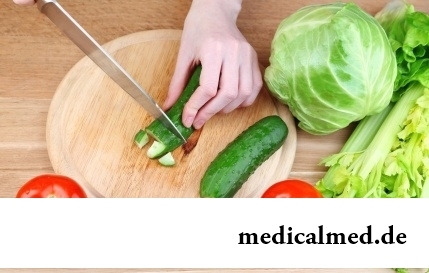
Very often as a source of the infection which caused a disease serves our house - the place which a priori has to be safe. However...
Section: Articles about health
People know that thermal sources have salutary force long ago. Treatment by natural waters is one of the most ancient methods of disposal of the most different diseases. Bathtubs, souls, wrappings and inhalations, in combination with reception of water vnut...
Section: Articles about health
More than a half of the married couples which faced prostatitis – leave. The new broadcast "Female View of Prostatitis" will help to learn – whether you have or your relatives problems....
Section: Articles about health
Almost each of us during life faced dissatisfaction with own body. At such moments, as a rule, we beginning...
Section: Articles about health
Deciding to get rid of an addiction, not all imagine what effects it is necessary to face. Process of refusal of smoking causes quite essential discomfort in most of people: differences of mood, sleep disorder, fatigue, decrease физич...
Section: Articles about health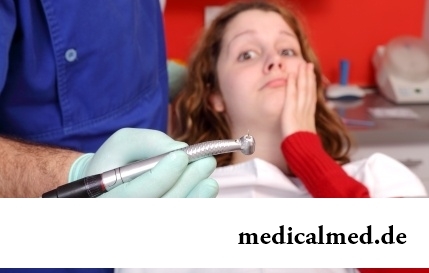
Statistically, can only one of ten of our compatriots brag of a decent condition of an oral cavity. Six teeth affected with caries are the share of the average Russian. For comparison, this indicator for Europeans is almost six times less....
Section: Articles about health
The varicosity has familiarly many, statistically, this disease more than a half of all adult population. As...
Section: Articles about health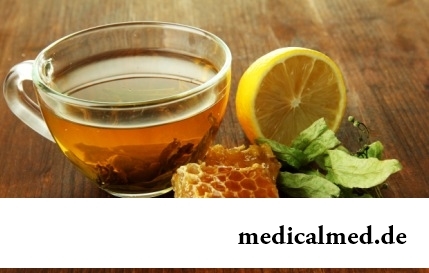
Cold – a state known to everyone which is followed by cold, cough, high temperature, a pharyngalgia. Often the first that we begin to do in hope again to become healthy – to accept medicines which are not always harmless, then...
Section: Articles about health
Bathing in broths of medical flowers and plants (phytobathtub) was eurysynusic since Cleopatra who is a good judge in all that concerns beauty and health. And today phytobathtubs is the simple and available means allowing not only to remove nervous tension, but also to recover from many diseases. Grass bathtubs at treatment of cold, osteochondrosis, radiculitis, skin diseases, and also diseases of urinary tract and vessels are especially effective....
Section: Articles about health
Any person who faced a disease knows that treatment costs expensive. It belongs also to consultations qualified the specialist...
Section: Articles about health
Contrary to popular belief, the multiple sclerosis (MS) is not connected neither with sclerous changes of walls of vessels, nor with age forgetfulness and problems with concentration of attention. This disease has the autoimmune nature. Pathological process of a vyrazh...
Section: Articles about health
Small appetite at the child – the complaint which pediatricians should hear practically from each mother. Most often it is carried to the category of children's whims, however the refusal of food in certain cases can be to alarming symptoms therefore it cannot be ignored....
Section: Articles about health
